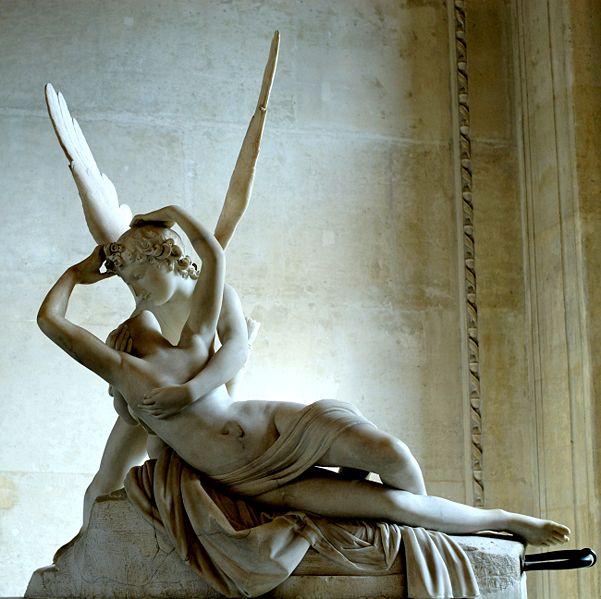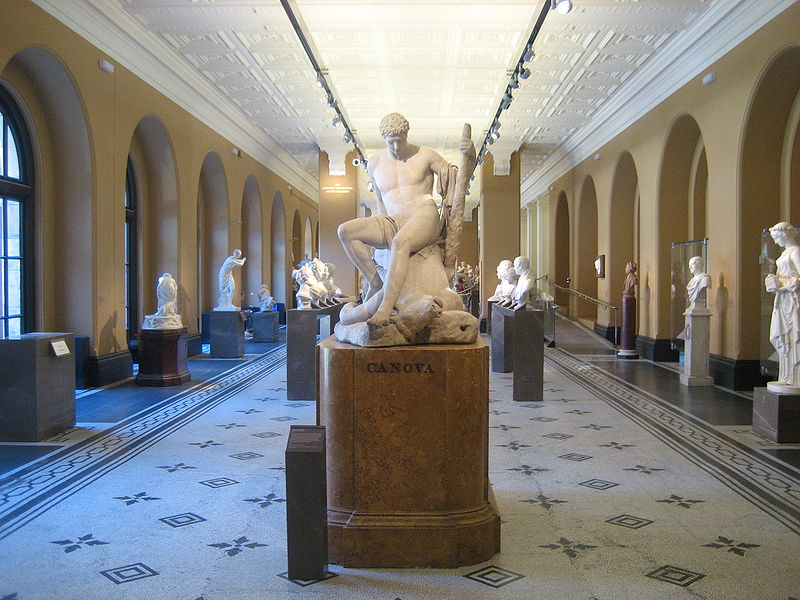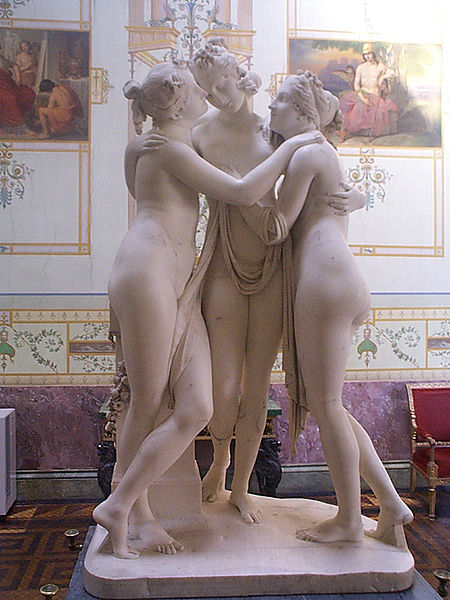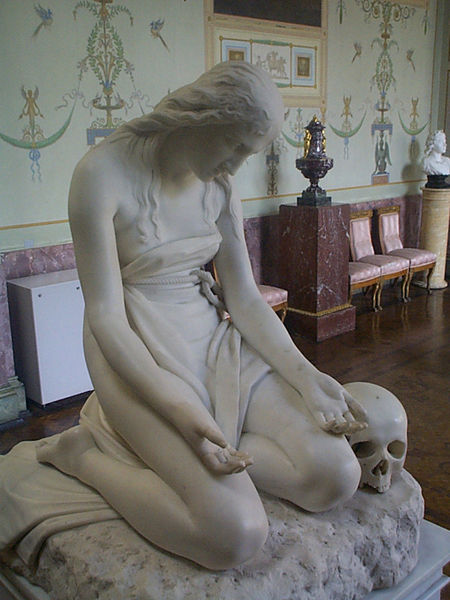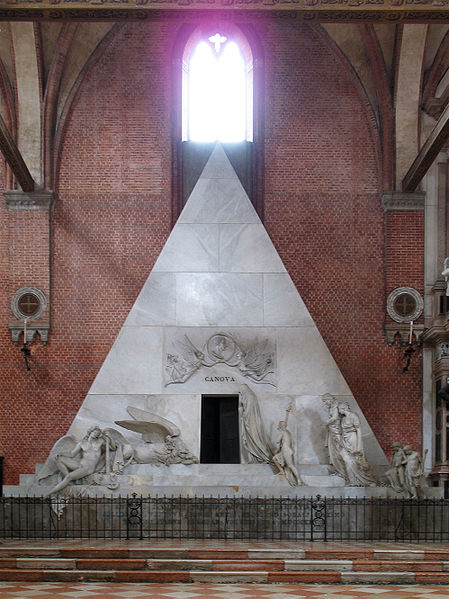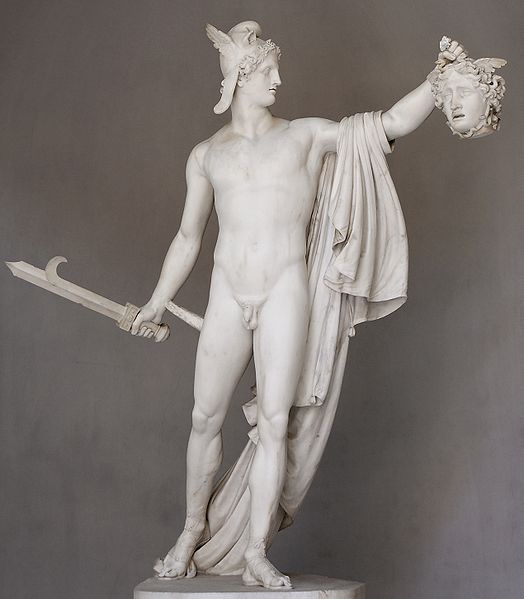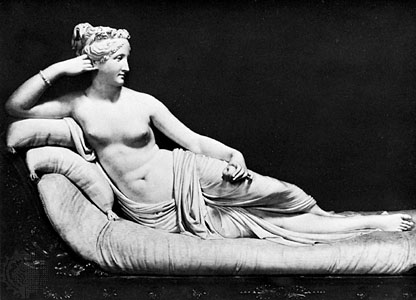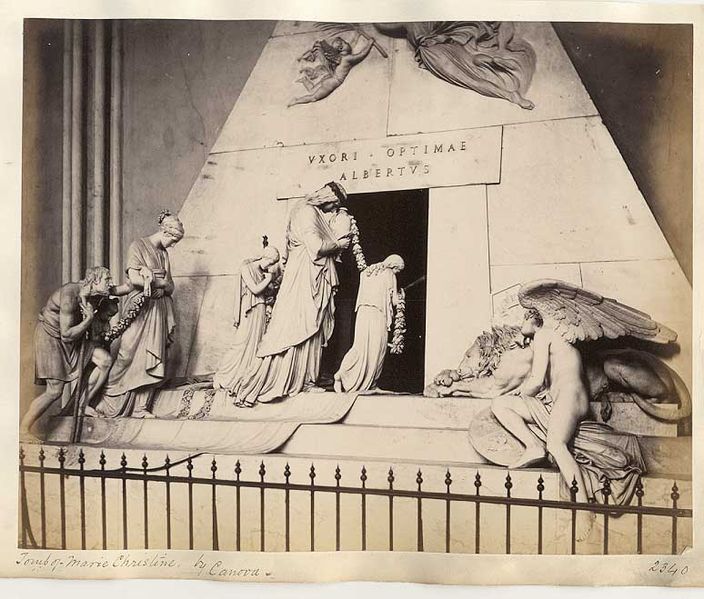<Back to Index>
- Physician Crawford Williamson Long, 1815
- Sculptor Antonio Canova, 1757
- 1st Minister of Education Ivan Ivanovich Shuvalov, 1727
PAGE SPONSOR
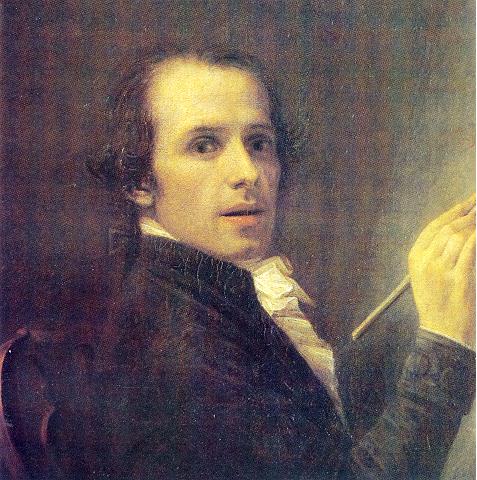
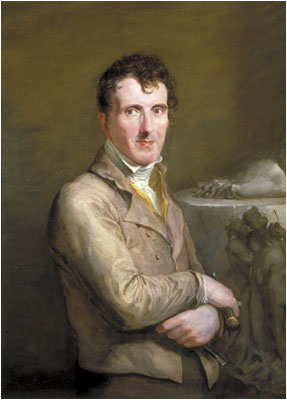
Antonio Canova (1 November 1757 – 13 October 1822) was a Venetian sculptor who became famous for his marble sculptures that delicately rendered nude flesh. The epitome of the neoclassical style, his work marked a return to classical refinement after the theatrical excesses of Baroque sculpture.
Antonio Canova was born in Possagno, a village of the Republic of Venice situated amid the recesses of the hills of Asolo, where these form the last undulations of the Venetian Alps, as they subside into the plains of Treviso. At three years of age Canova was deprived of both parents, his father dying and his mother remarrying. Their loss, however, was compensated by the tender solicitude and care of his paternal grandfather and grandmother, the latter of whom lived to experience in her turn the kindest personal attention from her grandson, who, when he had the means, gave her an asylum in his house at Rome. His father and grandfather followed the occupation of stone-cutters or minor statuaries; and it is said that their family had for several ages supplied Possagno with members of that calling. As soon as Canova's hand could hold a pencil, he was initiated into the principles of drawing by his grandfather Pasino. The latter possessed some knowledge both of drawing and of architecture, designed well, and showed considerable taste in the execution of ornamental works. He was greatly attached to his art; and upon his young charge he looked as one who was to perpetuate, not only the family name, but also the family profession. The early years of Canova were passed in study. The bias of his mind was to sculpture, and the facilities afforded for the gratification of this predilection in the workshop of his grandfather were eagerly improved. In his ninth year he executed two small shrines of Carrara marble, which are still extant. Soon after this period he appears to have been constantly employed under his grandfather. Amongst those who patronized the old man was the patrician family Falier of Venice, and by this means young Canova was first introduced to the senator of that name, who afterwards became his most zealous patron.
Between the younger son, Giuseppe Falier, and the artist a friendship commenced which terminated only with life. The senator Falier was induced to receive him under his immediate protection. It has been related by an Italian writer and since repeated by several biographers, that Canova was indebted to a trivial circumstance - the moulding of a lion in butter - for the warm interest which Falier took in his welfare. The anecdote may or may not be true. By his patron Canova was placed under Bernardi, or, as he is generally called by filiation, Giuseppe Torretto, a sculptor of considerable eminence, who had taken up a temporary residence at Pagnano, one of Asolo's boroughs in the vicinity of the senator's mansion. This took place whilst Canova was in his thirteenth year; and with Torretto he continued about two years, making in many respects considerable progress. This master returned to Venice, where he soon afterwards died; but by the high terms in which he spoke of his pupil to Falier, the latter was induced to bring the young artist to Venice, whither he accordingly went, and was placed under a nephew of Torretto. With this instructor he continued about a year, studying with the utmost assiduity.
After the termination of this engagement he began to work on his own account, and received from his patron an order for a group, Orpheus and Eurydice. The first figure, which represents Eurydice in flames and smoke, in the act of leaving Hades,
was completed towards the close of his sixteenth year. It was highly
esteemed by his patron and friends, and the artist was now considered
qualified to appear before a public tribunal. The
kindness of some monks supplied him with his first workshop, which was
the vacant cell of a monastery. Here for nearly four years he labored
with the greatest perseverance and industry. He was also regular in his
attendance at the academy, where he carried off several prizes. But he
relied far more on the study and imitation of nature. A large portion
of his time was also devoted to anatomy, which science was regarded by
him as the secret of the art. He likewise frequented places of public
amusement, where he carefully studied the expressions and attitudes of
the performers. He formed a resolution, which was faithfully adhered to
for several years, never to close his eyes at night without having
produced some design. Whatever was likely to forward his advancement in
sculpture he studied with ardour. On archaeological pursuits he
bestowed considerable attention. With ancient and modern history he
rendered himself well acquainted and he also began to acquire some of
the continental languages. Three
years had now elapsed without any production coming from his chisel. He
began, however, to complete the group for his patron, and the Orpheus which
followed evinced the great advance he had made. The work was
universally applauded, and laid the foundation of his fame. Several
groups succeeded this performance, amongst which was that of Daedalus and Icarus,
the most celebrated work of his noviciate. The terseness of style and
the faithful imitation of nature which characterized them called forth
the warmest admiration. His merits and reputation being now generally
recognized, his thoughts began to turn from the shores of the Adriatic to the banks of the Tiber, for which he set out at the commencement of his twenty-fourth year. Before
his departure for Rome, his friends had applied to the Venetian senate
for a pension, to enable him to pursue his studies without
embarrassment. The application was ultimately successful. The stipend
amounted to three hundred ducats (about 60 pounds per annum), and was
limited to three years. Canova had obtained letters of introduction to
the Venetian ambassador, the Cavaliere Zulian, and enlightened and
generous protector of the arts, and was received in the most hospitable
manner. His
arrival in Rome, on 28 December 1780, marks a new era in his life. It
was here he was to perfect himself by a study of the most splendid
relics of antiquity, and to put his talents to the severest test by a
competition with the living masters of the art. The result was equal to
the highest hopes cherished either by himself or by his friends. The
work which first established his fame at Rome was Theseus Vanquishing the Minotaur, now in the collections of the Victoria & Albert Museum, in London.
The figures are of the heroic size. The victorious Theseus is
represented as seated on the lifeless body of the monster. The
exhaustion which visibly pervades his whole frame proves the terrible
nature of the conflict in which he has been engaged. Simplicity and
natural expression had hitherto characterized Canova's style; with
these were now united more exalted conceptions of grandeur and of
truth. The Theseus was regarded with fervent admiration. Canova's next undertaking was a monument in honor of Clement XIV;
but before he proceeded with it he deemed it necessary to request
permission from the Venetian senate, whose servant he considered
himself to be, in consideration of the pension. This he solicited, in
person, and it was granted. He returned immediately to Rome, and opened
his celebrated studio close to the Via del Babuino. He spent about two
years of unremitting toil in arranging the design and composing the
models for the tomb of the pontiff. After these were completed, other
two years were employed in finishing the monument, and it was finally
opened to public inspection in 1787. The work, in the opinion of
enthusiastic dilettanti, stamped the author as the first artist of modern times. After five years of incessant labor, he completed another cenotaph, to the memory of Clement XIII, which raised his fame still higher. Works now came rapidly from his chisel. Amongst these is Psyche,
with a butterfly, which is placed on the left hand, and held by the
wings with the right. This figure, which is intended as a
personification of man's immaterial part, is considered as in almost
every respect the most faultless and classical of Canova's works. In
two different groups, and with opposite expression, the sculptor has
represented Cupid with
his bride; in the one they are standing, in the other recumbent. These
and other works raised his reputation so high that the most flattering
offers were sent to him from the Russian court to induce him to remove
to St Petersburg, but these were declined, although many of his finest works made their way to the Hermitage Museum.
"Italy", says he, in writing of the occurrence to a friend, "Italy is
my country - is the country and native soil of the arts. I cannot leave
her; my infancy was nurtured here. If my poor talents can be useful in
any other land, they must be of some utility to Italy; and ought not
her claim to be preferred to all others?" Numerous
works were produced in the years 1795-1797, of which several were
repetitions of previous productions. One was the celebrated group
representing the Parting of Venus and Adonis. This famous production was sent to Naples. The French Revolution was
now extending its shocks over Italy; and Canova sought obscurity and
repose in his native Possagno. Thither he retired in 1798, and there he
continued for about a year, principally employed in painting, of which
art also he had some knowledge. Events in the political world having
come to a temporary lull, he returned to Rome; but his health being
impaired from arduous application, he took a journey through a part of Germany,
in company with his friend Prince Rezzonico. He returned from his
travels much improved, and again commenced his labors with vigour and
enthusiasm.
The
events which marked the life of the artist during the first fifteen
years of the period in which he was engaged on the above-mentioned
works scarcely merit notice. His mind was entirely absorbed in the
labors of his studio, and, with the exception of his journeys to Paris, one to Vienna, and a few short intervals of absence in Florence and other parts of Italy, he never quit Rome. In his own words, "his statues were the sole proofs of his civil existence." There
was, however, another proof, which modesty forbade him to mention, an
ever-active benevolence, especially towards artists. In 1815 he was
commissioned by the Pope to superintend the transmission from Paris of
those works of art which had formerly been conveyed thither under the
direction of Napoleon.
By his zeal and exertions - for there were many conflicting interests
to reconcile - he adjusted the affair in a manner at once creditable to
his judgment and fortunate for his country. In the autumn of this year he gratified a wish he had long entertained of visiting London, where he received the highest tokens of esteem. The artist for whom he showed particular sympathy and regard in London was Benjamin Haydon,
who might at the time be counted the sole representative of historical
painting there, and whom he especially honored for his championship of
the Elgin marbles, then recently transported to England, and ignorantly depreciated by polite connoisseurs. Among Canova's English pupils were sculptors Sir Richard Westmacott and John Gibson. Canova
returned to Rome in the beginning of 1816, with the ransomed spoils of
his country's genius. Immediately after, he received several marks of
distinction: he was made President of the Accademia di San Luca, the
main artistic institution in Rome, and by the hand of the Pope himself
his name was inscribed in "the Golden Volume of the Capitol", and he
received the title of Marquis of Ischia, with an annual pension of 3000 crowns. He now contemplated a great work, a colossal statue of Religion.
The model filled Italy with admiration; the marble was procured, and
the chisel of the sculptor ready to be applied to it, when the jealousy
of churchmen as to the site, or some other cause, deprived the country
of the projected work. The mind of Canova was inspired with the warmest
sense of devotion, and though foiled in this instance he resolved to
consecrate a shrine to the cause. In his native village he began to
make preparations for erecting a temple which was to contain, not only
the above statue, but other works of his own; within its precincts were
to repose also the ashes of the founder. Accordingly he repaired to
Possagno in 1819. After the foundation-stone of this edifice had been
laid, Canova returned to Rome; but every succeeding autumn he continued
to visit Possagno, in order to direct the workmen, and encourage them
with pecuniary rewards and medals. In
the meantime the vast expenditure exhausted his resources, and
compelled him to labor with unceasing assiduity notwithstanding age and
disease. During the period which intervened between commencing
operations at Possagno and his decease, he executed or finished some of
his most striking works. Amongst these were the group Mars and Venus, the colossal figure of Pius VI, the Pietà, the St John, the recumbent Magdalen. The last performance which issued from his hand was a colossal bust of his friend, the Count Cicognara. In
May 1822 he paid a visit to Naples, to superintend the construction of
wax moulds for an equestrian statue of the perjured Bourbon king Ferdinand VII.
This journey materially injured his health, but he rallied again on his
return to Rome. Towards the latter end of the year he paid his annual
visit to the place of his birth, when he experienced a relapse. He
proceeded to Venice, and expired there at the age of nearly sixty-five.
His disease was one which had affected him from an early age, caused by
the continual use of carving-tools, producing a depression of the ribs.
The most distinguished funeral honors were paid to his remains, which
were deposited in the temple at Possagno on 25 October 1822. His heart
was interred in a marble pyramid he designed as a mausoleum for the painter Titian in the church of Santa Maria Gloriosa dei Frari in Venice, now a monument to the sculptor.
